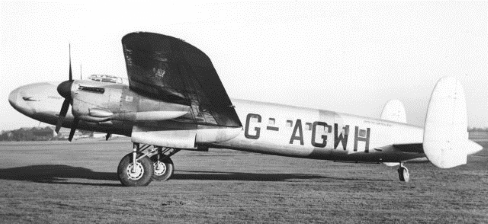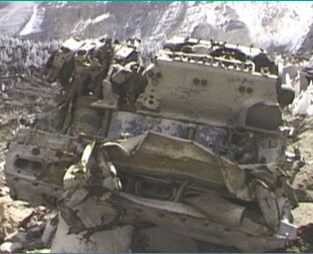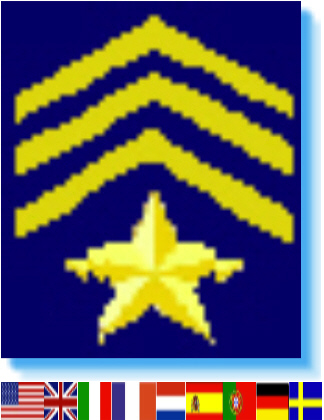

![]() SAR
Technology -
Aviation SAR Service
SAR
Technology -
Aviation SAR Service

- Cold Case Response -
67 Year-Old Aviation Cold Case Solved -
The Mysterious Last
Message of 'Start Dust'
 |
|
Lancastrian Aircraft 'G-AGWH' |
Background
On August 2nd 1947 British South American Airways aircraft G-AGWH, ‘Star Dust’,
was flying West over the High Andes, from Buenos Aires, Argentina to Santiago, Chile, when it disappeared. The
Lancastrian aircraft, with eleven people on board, never did arrive at
Santiago Airport and its location remained unsolved for over fifty years.
'Star Dust' did, however, broadcast a last, cryptic, Morse message; "STENDEC", which was received by Santiago Airport at 17:41 hrs - just four minutes before it's planned landing time. The aiport radio operator said the message was heard loud and clear but sent very quickly and so he asked for it to be repeated. A total of three messages were received, all of which were reported to be the same; “STENDEC”. Despite two official government investigations, BBC and Nova television documentaries, numerous websites and hundreds of attempts to resolve the meaning over the last 67 years the puzzling "STENDEC" message had "never been satisfactorily explained".
 |
|
Mount Tupungato 21,560 ft Credit: "Mount Tupungato" by Diode |
Wreckage
Discovery
In 1998 wreckage from
'Star Dust' was found by Argentinean climbers at the foot of a glacier below the 21,560 ft.
Mount Tupungato, the third highest peak
of the High Andes. Shortly afterwards an Argentine Army expedition reached the wreckage and began collecting evidence for an investigation of the aircraft’s crash.
Investigation
The investigation concluded that ‘Star Dust’, flying at 24,000 ft. - very
high for an aircraft at that time - probably entered the strong headwind of the powerful
jet stream, a little know phenomena at the time, which drastically reduced its real ground speed as it flew West. Having only primitive navigation equipment on board, without the benefit of radio beacons or GPS, the aircraft probably underestimated how far it had
travelled
West ![]() kmz and began its descent, in a “heavy snowstorm in very cloudy weather”,
too early - while still on the East side of the Andes
– for what it might have thought was the final approach towards Santiago Airport.
kmz and began its descent, in a “heavy snowstorm in very cloudy weather”,
too early - while still on the East side of the Andes
– for what it might have thought was the final approach towards Santiago Airport.
 |
|
'Star Dust' Engine |
|
|
|
'Star Dust' Wheel |
‘Start Dust’ crashed into Mount Tupungato’s steep upper snowfield and its remains were probably quickly covered by falling ice and snow. Over a period of fifty years the buried remains were gradually transported downhill within glacial ice, before eventually re-appearing at the foot of the glacier at the 15,000 ft elevation, at the location 33°22′15″S 69°45′40″W.
![]() "STENDEC"
Message
"STENDEC"
Message
While the probable cause of the aircraft accident appears to have been determined the meaning of the final, inexplicable
"STENDEC"
message, broadcast three times, had never been satisfactorily explained, despite
the "hundreds of
attempts" proposed over the years.
The following is believed to be the most probable and factually consistent explanation of
the long-standing "STENDEC" mystery.
![]() Message Analysis
Message Analysis
1.
The operator at the Los Cerrillos, Santiago Airport was probably in error when
he reported receiving the very quickly sent message as the word “STENDEC”
2. The “STENDEC” message was sent in
Morse code, which translates to ... - . -. -.. . -.-.
3. The “STENDEC” message was
sent very quickly, possibly because the radio operator believed they were only
four minutes away from the expected landing time.
4. The operator at the airport may have been in error when he reported receiving
replies that repeated the “STENDEC” message twice more.
5. The
three messages may have simply been the aircraft radio operator following the common practise of broadcasting each message
three times,
when attempting to establish a radio communication under difficult conditions.
6. The aircraft’s radio operator may never have heard the transmission from Santiago
Airport, on the opposite side of the Andes, and so continued to repeat the same message in triplicate, reported as “STENDEC”.
![]() 7. It is common practise, to this day, for a radio operator to
transmit
first the name of the radio station they wish to contact.
7. It is common practise, to this day, for a radio operator to
transmit
first the name of the radio station they wish to contact.
For example a “Base” station trying to contact a mobile unit “Mobile1” would typically transmit the message from Base as
“Mobile1 this is Base”.
An even shorter abbreviation, used in the era of Morse code, would be to transmit just the name of the
station they wish to reach, e.g. “Mobile1 over”, repeated three times to try and establish the initial communication.
 |
|
|
![]()
8. The
ICAO call sign i.e. station identifier, for the destination Los
Cerrillos,
Santiago Airport, is SCTI
9. ‘Over' or 'end-of-message’, in Morse code is often given the abbreviation
AR
10. Together, requesting an acknowledgement from the Los Cerrillos,
Santiago Airport would be broadcast by ‘Star Dust’ as “SCTIAR” i.e.
“SCTI over”, probably repeated three times.
11. The radio transmission from ‘Star Dust’, heard by the airport as “STENDEC”, has the following
Morse code sentence:
![]() S T E N D E C
transmits in Morse code as:
... - . -. -.. . -.-.
S T E N D E C
transmits in Morse code as:
... - . -. -.. . -.-.
If ‘Star Dust’ was following the common protocol of broadcasting first the call sign (radio identifier) of the airport it was wishing to contact, then this would have been sent as:
S C T I A R
transmitted in Morse code as: ![]()
12. Comparing the actual Morse transmissions for “STENDEC” and
“SCTI
over” it can be seen that these two messages have an
identical sequence
of Morse dots and dashes, making it easy for the
airport radio operator to have incorrectly interpreted the broadcast message as
"STENDEC":

![]() S T E N D E C
... - .
-. -.. . -.-.
S T E N D E C
... - .
-. -.. . -.-.
![]() S C T I A R
... -.-. - ..
.- .-.
S C T I A R
... -.-. - ..
.- .-.
13. The airport radio operator, hearing the second and third transmissions as identical in Morse to the first transmission, probably assumed that they were the same as his first, but incorrect, interpretation as "STENDEC".
 Morse:
Morse: ![]() STENDEC
STENDEC ![]() SCTIAR
(Fast, 35 words per minute).
SCTIAR
(Fast, 35 words per minute).
 Morse:
Morse: ![]() STENDEC
STENDEC ![]() SCTIAR
(FCC requirement 20
words per minute).
SCTIAR
(FCC requirement 20
words per minute).
14. ICAO had only recently implemented four-letter airport call signs, e.g 'SCTI', just four months earlier, in April 1947, so it is possible that the airport radio operator was not yet familiar with its call sign and may not have immediately recognized it.
15. 'Star Dust's radio operator would have only transmitted the airport's "SCTIAR" call sign, as it is standard practise to not broadcast other messages until the initial contact has been established.
Conclusions
It appears highly probable that the radio operator at the Los Cerrillos,
Santiego Airport had actually received the transmission from ‘Star Dust’ of the
airport's correct “SCTI over” call sign but mis-heard
or mis-understood the fast-sent transmission as “STENDEC”. The second two transmissions of the
airport's “SCTI
over” call sign by ‘Star Dust’ were probably recognized as
sounding identical to the first Morse transmission but were incorrectly interpreted again as “STENDEC”.
The “SCTI
over” transmission appears to be a plausible explanation of the long-standing
“STENDEC” mystery and one that is consistent with all of the facts and operational practices of that period.
Martin Colwell. SAR Technology Inc.
Lawrence Hooper. Radio Operator (retired)
Copyright 2016
SAR Technology Inc. All Rights Reserved.
 For more information please contact:
For more information please contact:
![]() SAR
Technology Inc.
SAR
Technology Inc.
 Phone:
(604) 921-2488
Phone:
(604) 921-2488  Fax
(604) 921-2484
Fax
(604) 921-2484
![]() sartechnology@telus.net
sartechnology@telus.net
![]() martincolwell Linked
in
martincolwell Linked
in
 |
SAR Technology Inc. |  |
View / Save / Share this webpage on your smartphone! Download Barcode Reader |
.